#CreepyHistory
Text
Hammersmith: A Haunting, A Hoax, and a Tragic Hunt
The calendar page had barely turned over to the new year and twenty-nine-year-old Francis Smith was experiencing one of the worst times of his life. He sat before the court positively morose for what he had done. On that awful night of January 3rd 1804 he immediately surrendered to the constable, deeply regretting how it all unfolded. Now all he could do was plead for mercy and understanding. After all, at that moment he truly believed he was acting on behalf of the entire borough when he shot the gun.
Over the course of twelve months the West London district of Hammersmith fell into a state of apprehension and deep fear. It all began when a man committed suicide by slashing his own throat and, in a move that went against all rule and beliefs, he was buried in the consecrated ground of the churchyard ensuring that his soul would never find peace. It was after this controversial burial that people began to report seeing a figure, draped in a white shroud, appearing throughout Hammersmith. Surely this had to be the tormented spirit of the man who committed suicide and was then committed to sacred ground. What other explanation could there be? If the incidents remained as ghostly sightings it may have never progressed beyond a simple haunted tale, but the encounters got violent, and then people allegedly began to die. A brewer’s servant named Thomas Broom later told how he was walking through the churchyard with a friend one night when he was suddenly grabbed violently by the throat. It was only when his friend turned to see what happened that he claimed the specter “gave me a twist round, and I saw nothing; I gave a bit of a push out with my fist, and felt something soft, like a great coat.” Another pair of stories alleged that an elderly woman and a pregnant woman both encountered the malevolent spirit on separate occasions near the churchyard and they were both so terrified that when they returned home they could not leave their beds, dying there a few days later.

An image of the Hammersmith Ghost attacking a woman. Image via The Newgate Calendar, Part III (1826), http://www.exclassics.com/newgate/ngconts.htm.
The people of Hammersmith were scared but some were also skeptical, believing this was not a ghost, but a cruel and devious human being. Ghost or human, either way their reign of terror had to be stopped. At this point Hammersmith did not have a formal police force so in order to protect the people some of its own citizens began patrolling the streets after dark. One of these men guarding the night was Francis Smith, armed with a shotgun, and another was night watchman William Girdler. On the night of January 3rd at approximately 10:30pm Girdler ran into Smith and told him that later that night he would meet up with him and they would look for the ghost together. Girdler knew what he was looking for after all, only a few days earlier on December 29thhe saw the ghost and chased him down but the figure disappeared into the darkness.

Engraving of the Hammersmith Ghost appearing in Kirby's Wonderful and Scientific Museum circa 1804. Image via Wikipedia.
Another man walking the streets that night was thirty-two year old bricklayer Thomas Millwood. He was visiting with his sister, mother, and father and as the clock moved closer to 11pm he stood up, said goodnight to his parents, and prepared to head back home for the evening. His sister Anne watched him walk away from the door. She wished he had listened to her and worn something over his work clothes of linen pants, a waistcoat, and an apron. They were recently washed and glowed bright white in the darkness. He had already been mistaken for the notorious Hammersmith Ghost at least twice before but he met any accusation with a scoff.
Within minutes she heard the voice, “Damn you. Who are you and what do you want? I’ll shoot you if you don’t speak.” Then she heard the gunshot.
Anne ran out into the dark and before long she made the horrifying discovery of her brother laying in the road, dead in a pool of blood, with his face mauled by a bullet. She was not alone with her brother, already with his body was nearby wine merchant John Locke, William Girdler, and Francis Smith. What happened spilled out of their mouths and fell into place quickly. Locke heard the gunshot and soon afterwards Smith rushed up to him, severely distressed, and told him he had just shot a man and asked him to go back to the scene with him. After they got back to Millwood’s body they were quickly joined by Girdler and Anne Millwood. When the constable arrived at the scene Smith accepted full responsibility for what happened. He was taken to Newgate Prison to await trial and the body of Thomas Millwood was taken to Black Lion Inn where it was examined by a surgeon who determined that the bullet went through his jaw and hit his spinal cord killing him instantly.
Smith’s trial began one week later and it might have seemed like a fairly straightforward case. He did admit to shooting Millwood, but it was not that simple. Despite taking responsibility for Millwood’s death, Smith entered a plea of Not Guilty based on his account that he felt he was not hunting an actual ghost, but a person acting as a ghost and terrorizing Hammersmith. When he saw the white figure he knew he was facing a man and he called out to him twice, telling him to name himself. When he did not stop or speak Smith said he became fearful for his life because the figure kept approaching him. He shot, but did not aim to kill, it was just an all around unfortunate accident. There were no witnesses to the crime so heavy reliance was placed on the few who arrived at the scene. Locke stated that when Smith met him and asked him to accompany him back to Millwood he was genuinely distraught and horrified at what happened. Several others testified about Smith’s honesty, integrity, and all-around good character. The only voice that spoke of any faults came from Anne Millwood who told the court that Smith shot so quickly after calling out for her brother’s name that there was no way he could have responded in time.

Illustration of the encounter between Smith and Millwood. Image via crimemagazine.com.
Smith had people vouching for him, but the judge Lord Chief Baron Macdonald was hearing none of it. He addressed his jury and plainly explained that there was no gray area here, that it was either murder or it was not. Smith went out into the night carrying a gun which spoke to his intent to harm someone. Millwood was simply walking home when he met his end. In the judge’s eyes this was not self-defense and Millwood was doing nothing to warrant Smith shooting his gun. According to him, it did not matter who Smith intended to hunt down. It also did not matter if Millwood was deliberately dressed as a ghost to scare the residents of Hammersmith, that offence did not deserve being shot. According to the judge no matter how the situation was spun, it occurred because of malice and this was why Smith must be found guilty of murder.
Surprisingly, the jury did not go along with the judge’s advice and when they returned it was with a verdict of guilty, but guilty of manslaughter. This was not accepted by Lord Chief Baron Macdonald and his fellow judges once again reminded the jury that they could not find Smith guilty of manslaughter, because it was not a possible outcome when the choices were either guilty of murder or acquitted of murder. Once again the jury consulted with each other and finding no other option, they returned with their verdict: Francis Smith was guilty of murder.
With the verdict came the sentence. Smith was sentenced to death by hanging followed by dissection the following Monday. Inconsolable, Smith had to be held up and carried from the court.
However, as hard-lined as Lord Chief Baron Macdonald was he was well aware of the public opinion that Smith did not deserve to be sentenced as a cold blooded killer. He added “The case gentlemen shall be referred to His Majesty immediately” to his judgement. This gave Smith one more chance, when a case was brought before the King he had the ultimate power to override and change the sentence. For Smith, those few words from Lord Chief Baron Macdonald saved his life. Before the sun rose the next morning his sentence was reduced to one year imprisonment with hard labor.
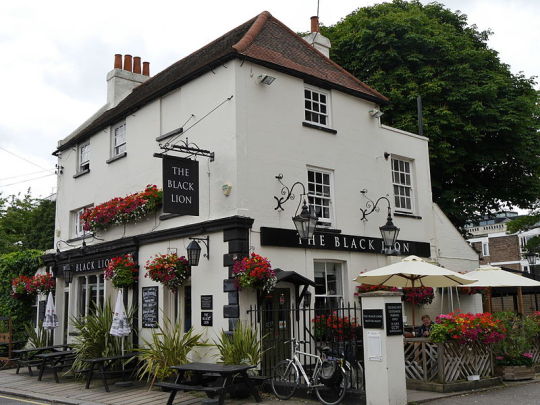
The Black Lion Inn, where Thomas Millwood’s body was taken and where Smith allegedly spent time before the shooting. Image via Wikipedia.
The Hammersmith Ghost, the terrifying being who attacked innocent citizens and was allegedly responsible for suffering, turmoil, and even death, was never heard from again. This is because two days after the death of Thomas Millwood the ghost came forward. A local shoemaker named John Graham admitted that he was the Hammersmith Ghost and that he had been dressing up as the specter to scare his apprentices as an act of revenge because they had been scaring his children with ghost stories. Graham surrendered to the authorities, but because there was no clear legal guidance on this situation he was set free on bail and all traces of him disappeared from record.
Francis Smith was given a full pardon on July 14th 1804.
While the haunting hoax promptly ended, the Hammersmith Ghost trial had far reaching implications when it exposed that there was very little defined in law when it came to people who acted out in a scenario where they believed action was required and carried out under good intentions or when the person acting out misread the situation. Did mistaken belief warrant a criminal charge? Smith was responsible for the death of Millwood, but he believed he was acting against someone who was bringing terror to the people of Hammersmith. The scenario would be brought up in a number of legal cases until it was finally settled in 1983 with the case of Regina v Williams during which the Court of Appeal finally clarified that:
“In a case of self-defence, where self-defence or the prevention of crime is concerned, if the jury came to the conclusion that the defendant believed, or may have believed, that he was being attacked or that a crime was being committed, and that force was necessary to protect himself or to prevent the crime, then the prosecution have not proved their case. If however the defendant’s alleged belief was mistaken and if the mistake was an unreasonable one, that may be a peaceful reason for coming to the conclusion that the belief was not honestly held and should be rejected. Even if the jury come to the conclusion that the mistake was an unreasonable one, if the defendant may genuinely have been labouring under it, he is entitled to rely upon it.”
In 1804 the people of Hammersmith were living in fear of a supernatural entity. This ghost story is still told, but not in front of campfires or on gloomy nights when the veil feels thin. The Hammersmith Ghost died in the same moment as Tom Millwood and today it is carried on not as a spine-chilling story about West London, but as a cautionary tale and a legal precedent that hung over the courts and haunted law practitioners for almost two centuries before it was finally laid to rest.
*******************************************************************************************
Sources:
The Case of the Murdered Ghost
http://news.bbc.co.uk/1/hi/england/london/3364467.stm
The Hammersmith Ghost and the Strange Death of Thomas Millwood by Martin Baggoley http://www.crimemagazine.com/hammersmith-ghost-and-strange-death-thomas-millwood
The Case of a Ghost Haunted England for Over Two Hundred Years by Kelly Buchanan https://blogs.loc.gov/law/2015/10/the-case-of-a-ghost-haunted-england-for-over-two-hundred-years/
The Time Someone Shot A Ghost Dead In Hammersmith by Jane Alexander https://londonist.com/london/features/hammersmith-ghost-story-murder
#husheduphistory#featuredarticles#Britishhistory#LondonHistory#legalhistory#paranormalhistory#ghoststory#famouscourtcases#tragictale#tragichistory#weirdhistory#strangehistory#forgottenhistory#creepyhistory#historyclass#history#oddhistory#truth is stranger than fiction#truestory#hoax#tragicmistake#ghost#courtroom
5 notes
·
View notes
Text
The Author of Sherlock Holmes Believed in Fairies? 🧚♀️🕵️♂️
I do not think I would be exaggerating if I suggest that anyone with access to TV or the internet has at least heard of Sherlock Holmes. If somehow you missed knowing, he is a fictional consulting detective in a series of stories, which started publishing in 1887.
"By the 1990s there were already over 25,000 stage adaptations, films, television productions and publications featuring the detective,[2] and Guinness World Records lists him as the most portrayed literary human character in film and television history."
Wikipedia
Much to the distain of the author (we will get back to that) the stories took the world by storm. Everyone just could not get enough of the cold and scientific detective, and created a massive fanbase constantly asking for more.

The author, Sir Arthur Conan Doyle, might seem like he would fit your assumptions of him with what everyone shares about him. He had a medical career, published academic papers, and was even called upon to help in��real life crime cases.
When Sherlock became a household name, Sir Arthur Conan Doyle became annoyed with his own creation. He wanted to kill Sherlock off, but his mother begged him not to. So, tried raising his prices to a rate publishers would not pay, but the publishers complied to the rates and he became one of the best paid authors in history.
Doyle did keep writing, but had another life that people tend to carefully leave out when they are writing about him; he was believer in the occult. That belief proved so strong that it once led him to trust in a scam.
Spiritualism was huge at the time — with parties of séance’s being surprisingly common — and he loved every bit of it. He joined The British Society for Psychical Research(which actually still exists today), started sharing all he could about spiritualism, and eventually it became his main focus. He even opened his own bookshop dedicated to all of this.
Within this urge to believe in the occult, he also believed in the famous Cottingley Fairies, which were faked photos of fairies by two school girls. Doyle was so convinced, that he wrote articles and a book on the subject.

“We submitted the negatives to Mr. Snelling, who was for 30 years expert of the Autotype Co. and Illingworth’s large photographic factory. He certified two things: (1) That it was a single exposure ; (2) that the figures were moving when taken. After getting this opinion, I submitted the negatives to two experts of the Kodak Company. They found no evidence of superposition or any other trick. Several minor authorities have given the same verdict. None have ever been able to pick any hole, though there have been several newspaper inquiries upon the subject. Every fresh fact which has come to light has served to strengthen the case for the honesty of the girls”
Spirits and Fairies is a letter written by Arthur Conan Doyle first published in The Evening News (Portsmouth) on 5 july 1926.
You might be wondering how one goes from the belief in ghosts to belief in fairies, but it is important to not that the realm of the dead and the realm of the fairies (the otherworld) are sometimes described as the same place. That’s why traditional Samhain(Halloween) customs involved both those things.
People at the time thought he went mad, but it was not all that rare for science-loving people to be curious about the supernatural back then. Even Marie Curie (who discovered the x-ray), and Thomas Edison(credited with inventing several things, including motion pictures), and Oliver Lodge(who helped developed the radio), were all known to dabble in the occult.
As well as that, there are still people today who still believe in both ghosts, supernatural abilities, and fairies.
Belief in these things might see a little crazy to many, but it is important to remember that most folkloric or religious beliefs seem strange from an outside perspective. From Doyle’s perspective, fairies and ghosts were as real as other things — such as bacteria or viruses — we can’t see, which is why he thought it was his duty to gather the science proof that would make the public believe too.
youtube
youtube
#fairies#fairy#fae#faerie#fay#folklore#sherlock#weirdhistory#weird history#creepyhistory#creepy history#history#Youtube#WeirdHistory
2 notes
·
View notes
Text
Embracing autumn in Spain!

Discover Spain's autumn charm, where vibrant foliage and cultural festivities create a unique seasonal experience. Explore the warmth of fall in this enchanting destination.
#AutumnInSpain#FallFoliage#MadridNights#FullMoonMagic#SpookySpain#GhostsOfSpain#EerieAdventures#HauntedCastles#CreepyHistory#SpainVisaLondon#HalloweenSpain#SpookyJourney#HistoricalHaunts#CreepySpain#travel
0 notes
Photo

‘Since loyalty does no man good, Let's steal the King, and outdo Blood! ‘ John Wilmot, 2nd Earl of Rochester On the 9th May 1671, Anglo-Irish officer Colonel Thomas Blood attempted to steal the Crown Jewels from the Tower of London. After integrating himself and his invented family with the Master of the Jewel House, Talbot Edwards, the group led by Blood overcame Edwards; and concealed crowns, spectre’s and orb’s into their clothing. Edwards managed to raise the alarmy, yelling "Treason! Murder! The crown is stolen!". Escaping from the scene Blood and his accomplices fired on the Warders, before they were captured, with Blood declaring, "It was a gallant attempt, however unsuccessful! It was for a crown!” Upon his capture Blood refused to answer to anyone but the King, and he was delivered before King Charles II. The King asked Blood, "What if I should give you your life?", with Blood replying, "I would endeavour to deserve it, Sire!” Amazingly Blood was not only pardoned but also given land in Ireland. An historical speculation for Charles' actions is that he had a respect for audacious scoundrels such as Blood. This can also be seen in Charles’ nickname of ‘Swift Nick’, given to highwayman and rogue John Nevison in 1676. Nevison was hanged for highway robbery on May 4th 1684. Blood died on the 22nd August 1680, however was exhumed shortly after to make sure that he did not fake his own death, continued in the comments. #macabreillustration #strangehistory #historicalillustration #historymystery #historymysteries #strangehistory #weirdhistory #macabrehistory #historicalmystery #historicalmysteries #darkhistory #oddhistory #historicalstories #historicalstory #darkillustration #illustrationartwork #historyfacts #darkacademia #creepyhistory #vintageaesthetic #medicinebottle #historyofmedicine #medicinehistory #ceramicbottle #ceramicbottles #charlesii #crimehistory #toweroflondon🇬🇧 #crownjewels #highwaymen https://www.instagram.com/p/CNAj5o5n2r3/?igshid=vn3gg5voc9pz
#macabreillustration#strangehistory#historicalillustration#historymystery#historymysteries#weirdhistory#macabrehistory#historicalmystery#historicalmysteries#darkhistory#oddhistory#historicalstories#historicalstory#darkillustration#illustrationartwork#historyfacts#darkacademia#creepyhistory#vintageaesthetic#medicinebottle#historyofmedicine#medicinehistory#ceramicbottle#ceramicbottles#charlesii#crimehistory#toweroflondon🇬🇧#crownjewels#highwaymen
0 notes
Photo

Fact of the day: Rumpelstiltskin and Rasputin are NOT the same person. . . Grigori Yefimovich Rasputin was born to a peasant family on January 21 1869 in Siberia, Russia. . . Thanks to Boney M, we all know he was Russia’s greatest love machine, drove women wild and was big and strong. . . But a more interesting part of the Rasputin myth is that he was a member of a secret Russian Orthodox Church sect called the Khlysts. . . They believed that the only way to achieve salvation was through “total repentance”, and it was easier to ask for forgiveness when you’ve REALLY sinned. . . Which might explain Rasputin’s reputation as a rampant shagger and frequent visitor to St. Petersburg’s brothels. . . Rasputin became a trusted advisor to the Tsar, but he was loathed for his “ungodly” exploits. He survived being viciously slandered... and being stabbed in the stomach. . . He was lured to the house of Felix Yusupov, husband of the Tsar’s niece, where he was shot three times and killed by a bullet to the forehead (⬅️ swipe to see! 💀) on 30 December 1916. . . . . . #rasputin #historicalfacts #onthisday #aquariusman #russia #famousbirthday #creepyhistory #corpse #tsar #Khlysts #cultleader #menwithlonghair #menwithbeards #sexy #lovemachine (at Saint Petersburg, Russia) https://www.instagram.com/p/CKUd26MFFLQ/?igshid=x83aaonfse3e
#rasputin#historicalfacts#onthisday#aquariusman#russia#famousbirthday#creepyhistory#corpse#tsar#khlysts#cultleader#menwithlonghair#menwithbeards#sexy#lovemachine
1 note
·
View note
Photo

Voy a estar de lleno el siguiente mes con el #inktober asi que adelanto mi dibujo para el mes de octubre y noviembre, pero no queria estar con el típico concepto Halloween y dia de muertos asi que use 2 conceptos que casi no veo en estas fechas, disfraze a mi OC's de #catrin y #kuchisakeonna Posdata: como odio no saber hacer fondos T^T I'm gonna spent all my free time for the next inktober so this is the draw for the dates of October and November, These are my #oc 's and they costumes are about two concepts that I would like to see more often, a Catrin (Mexican culture) and the kuchisake onna I hope you like the illustration Btw can someone teach how to make good background for my drawings ^^! #ink #traditionaldraw #traditionalcolor #costumeparty #costume #smoking #kimono #creepypastacosplay #creepyhistory #scaryhistory #inktober2018 #devilcostume #leyendas #historiasdeterror https://www.instagram.com/p/BoRyRRKAwNT/?utm_source=ig_tumblr_share&igshid=1q5cqaieg8p3a
#inktober#catrin#kuchisakeonna#oc#ink#traditionaldraw#traditionalcolor#costumeparty#costume#smoking#kimono#creepypastacosplay#creepyhistory#scaryhistory#inktober2018#devilcostume#leyendas#historiasdeterror
0 notes
Photo

When I tour churches I always look for the ugliest Mary and the creepiest thing. Relics are always high on my list of creepy. Relics are pieces of bone said to belong to various monks, clergy, saints, even Jesus himself. You can see the bone chips here in the wrists of these reliquaries. #catholic #catholicchurch #church #uglymary #relics #boneshards #bone #bonechips #monks #saints #clergy #pope #bishop #cardinal #creepy #relics #catholicrelics #metalhands #sacred #travel #explore #history #creepyhistory #italy #speechlessplaces #theunkown #tuscany #Firenze #siena #unknown http://bit.ly/2QYvjtz
0 notes
Text
Ghost Blimp: The Mystery and Missing on the L-8
On Sunday, August 16th 1942 Richard L. Johnston was going about his business. He had just finished waxing his car in Dale City, California when he looked up and saw something huge creeping out of the sky and towards his house. Suddenly it hit a utility pole, electrical wires broke sending sparks cascading down to the street, and Johnson ran into the house to protect his mother. When he came back outside there was a large group of people in the street including Fire Deputy Marshal Sean Wood and Johnston’s next door neighbor, volunteer fireman William Morris. Johnston’s car was completely hidden under a massive fold of what looked like canvas. When Johnston woke up that morning he probably didn’t expect that a blimp would land on his car that day. And yet, moments later the scene became even more bizarre.
In August 1942 the United States Navy was on high alert. Within nine months after entering World War II Japanese submarines sunk at least six Allied ships off the American west coast and shelled one of California’s largest oil drilling facilities. The fear of another attack on American soil was high and in order to keep an eye on the sea along the west coast the Navy took to the air, deploying blimps to cruise over the ocean and watch for any suspicious activity.
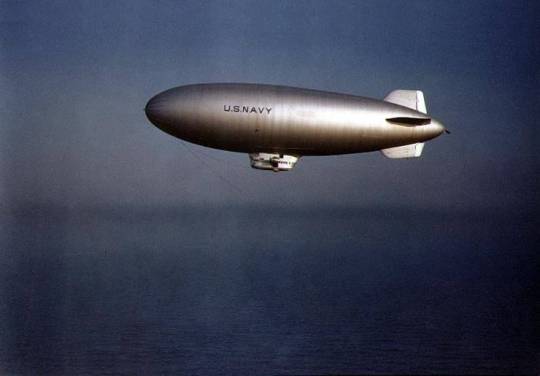
World War II Navy blimp. Image via Wikimedia Commons.
The blimp that landed on Johnson’s car was the L-8 airship, acquired by the Navy from the Goodyear company and commissioned on March 5, 1942. It was an excellent machine, completing over 1,000 trips and never requiring any work beyond routine maintenance. The two-man crew tasked with piloting the airship had records as impeccable as the craft itself. Lieutenant Ernest Dewitt Cody was a 1938 graduate of Annapolis and although he was only twenty-seven years old he was highly regarded with his commanding officer describing him as “one of the most capable pilots and one of the most able officers” under his command. Cody was relatively new to flying LTA (lighter-than-air) airships, but in April 1942 he proved his ability when he flew the L-8 to deliver cargo to the USS Hornet before the ship departed for Doolittle’s Raid over Tokyo. It was that trip that earned him his promotion to Lieutenant in June 1942. Ensign Charles Ellis Adams was eleven years older than Cody and had twenty years of experience flying LTA airships, but only earned his commission the day before their flight together making his trip with Cody his first flight as an officer.

Lieutenant Ernest Dewitt Cody and Ensign Charles Ellis Adams.
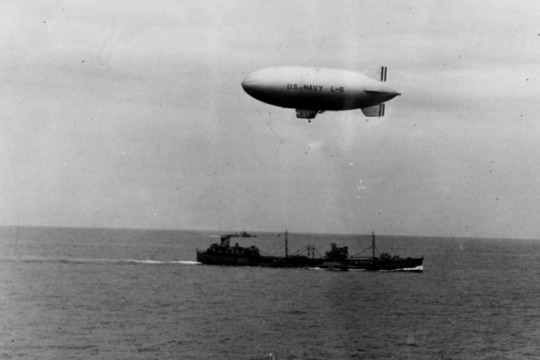
The L-8 delivering cargo to the USS Hornet. Image via National Archives.
Their task together was a routine anti-submarine mission, fly out from Treasure Island, patrol a fifty-mile radius of San Francisco, then head to the Farallon Islands before heading back to Treasure Island. When they left Treasure Island at 6:03am there was approximately five miles of visibility with the Golden Gate Bridge off in the distance. At 7:38am Cody radioed Moffett Field and reported their location as being four miles east of the Farallon Islands. Four minutes later Moffett Field received a second message from Cody, “Am investigating suspicious oil slick—stand by.” Since an oil slick could indicate an enemy submarine below the waves it was not unusual for the airship to investigate the scene. As the L-8 descended closer to the sea its movements were seen by a fishing boat, the Daisy Gray, and a Liberty cargo ship, Albert Gallatin. Apprehensive about seeing the Navy airship creep closer to the surface of the water and then set off two flares, the ship crews pulled in their nets, manned their guns, and nervously waited to see what happened next. But, as they watched the L-8 nothing out of the ordinary happened. The blimp circled for about an hour and crews from both ships could see two men in the gondola. At approximately 9am the blimp again rose into the air and restarted its route back toward San Francisco. Everything appeared normal to the ships and spectators below, but personnel at Moffett Field were getting nervous, they had not heard a word from the L-8 since 7:42am and were not able to reestablish any communication. Two Vought OS2U Kingfisher floatplanes were sent to look for the blimp and other aircraft were asked to keep their eyes open.

The intended flight path of the L-8 aircraft. Image via unsolvedmysteries.fandom.com.
At approximately 10:49am a series of blimp sightings began to roll in. A Pan American Clipper pilot reported seeing the blimp over the Golden Gate Bridge, then at 11am one of the Kingfishers spotted the L-8 three miles west of Salada Beach at approximately 2,000 feet. Although a height of 2,000 feet would typically be avoided by an airship for safety reasons, there was no indication of the ship being out of control or in danger and it began to descend. The next plane to spot the blimp, an Army P-38 pilot, also saw no indication that the airship or its crew was in any distress when it was seen near Mile Rock, seemingly on its way back to Treasure Island. Within minutes an off-duty seaman named Richard Quam saw the L-8 as he was driving along the highway between San Mateo and San Francisco and he decided to take a picture of the sight. He may have been the first person to capture that something was amiss, the blimp was now noticeably bending in the middle.
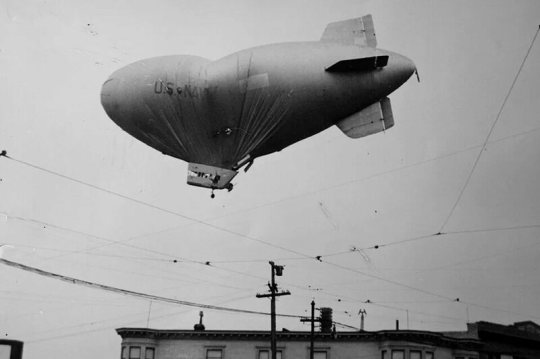
The L-8 airship visible sagging as it flew over Daly City. Image via National Archives.
Things began to happen quickly. At approximately 11:15am the L-8 was seen approaching the shore of Ocean Beach in San Francisco but its motors were now silent and there was noticeable sagging. It touched down on the beach for a moment but kept moving until it hit the side of a hill, knocking off one of its 325lb depth chargers. Now carrying 300lbs less, the airship again rose, clearing the hill, and moving further inland. Thousands of people now watched as the L-8 staggered overhead obviously in peril. But, according to witnesses, the ship was not unmanned, in a later interview seventeen-year-old C.E. Taylor told reporters that as the blimp descended he was watching the cabin through his binoculars and that two men were clearly visible inside the entire time.
Finally, at 11:30am the blimp came to a clumsy rest on top of Richard Johnston’s freshly waxed car. Sirens blared and firemen surrounded the blimp, slashing it open in an attempt to save Cody and Adams inside. But, when the rescuers got to the gondola they found a scene that made no sense. The door was open, the microphone for communication was hanging from the doorway, a hat was resting on the controls, the life raft and all parachutes were still in place, but Cody and Adams were nowhere to be found.
Once the initial shock of the crash wore off a feeling of worry began to quickly take over. The L-8 was traveling an extremely visible route and was tracked and seen by hundreds of people and ships, with many reporting the same as young C. E. Taylor, that the men were visible inside the cabin. The Navy immediately launched a search for Cody and Adams and the craft was inspected for any clues to solve the disappearance. The engines were in perfect running order, the ignition switches were on, and there was four hours of fuel left. The only thing that was unusual on board was that the blimp's batteries were drained and part of the fuel supply had been dumped out with no obvious explanation why.
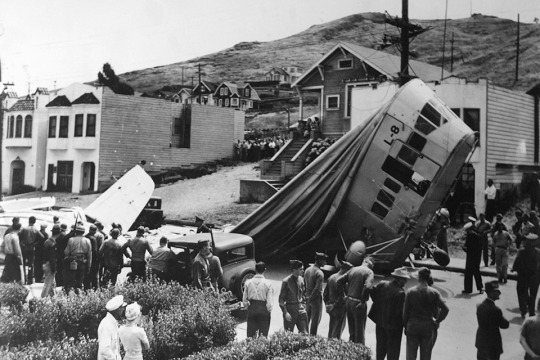
The scene after the crash of the L-8. Image via National Archives.
For three days the shore where the blimp initially crashed and the Pacific coastline was heavily searched but there was no trace of the two missing men. A board of investigation was convened by Navy Commander Francis Connell and over the course of seven days thirty-five witnesses gave their testimony of watching the L-8 hover overhead with nothing seeming suspect. Multiple people both on land and at sea at the time reported seeing the men inside and there being no indication that they ever fell or jumped out of the gondola. In the end it was determined that "no fire, no submersion, no misconduct, and no missiles struck the L-8.” While that may have answered some questions the big one still remained, what happened on the L-8 between 7:42am and 11:15am that made two Navy officers stop communication and vanish before crashing their blimp in a residential neighborhood?
Unfortunately, there were many theories but no concrete answers to that question. Some believed it was a simple tragic accident, that a malfunction with the door led to one man falling out at a low altitude and the other following him out in an attempt to save him before they were both lost to the sea. Others proposed much more elaborate theories, that the men were secret spies, that they were lured close to the surface of the water and grabbed by enemy forces, and some even said that the men ended up killing each other by falling out of the blimp during an argument over a woman. Some guesses tried to remain optimistic, that the men fell out but they were able to swim to shore and would be found hiking back to civilization any day now. Maybe they were picked up by a passenger ship after falling from the aircraft, they just had to wait until they were returned home. But, time ticked forward and the men never reappeared. Shortly after the crash the wives of both men were told that their husbands were officially missing. It was becoming painfully obvious this was not going to change and one year after their disappearance the men were declared dead. The Navy officially classified the incident as “100% Unknown/ Undetermined.”
The L-8 was repaired and continued to be used as a training vessel until the end of World War II when it was returned to Goodyear Tire and Rubber Company. It was refurbished, renamed America, and was used to broadcast sports events until it was finally retired in 1982.
Nearly eighty years after the disappearance of Lieutenant Ernest Dewitt Cody and Ensign Charles Ellis Adams there is still no official explanation as to what happened on that clear August morning over the Pacific coast
After its retirement the gondola of the L-8 was fully restored and is currently exhibited at the National Museum of Naval Aviation in Pensacola, Florida.

The refurbished gondola of the L-8 on display at the National Museum of Naval Aviation. Image via www.history.navy.mil.
*************************************************
Sources:
Mystery of the Ghost Blimp by John J. Geoghegan https://www.historynet.com/mystery-of-the-ghost-blimp.htm.
The Crew of the L- 8, https://unsolvedmysteries.fandom.com/wiki/The_Crew_of_the_L-8
The Bizarre Tale Of The World War II Ghost Blimp And Its Missing Crew by Gina Dimuro, https://allthatsinteresting.com/ghost-blimp
In 1942, a war blimp fell out of the sky onto Daly City. Its crew was never found by Katie Dowd and Andrew Chamings, https://www.sfgate.com/sfhistory/article/SF-Ghost-blimp-Daly-City-15739903.php
Ghost Blimp Mystery of WW2 – Crashed in San Francisco & Crew Was Never Found by Ruslan Budnik, https://www.warhistoryonline.com/instant-articles/mystical-disappearance-pilots.html.
#HushedUpHistory#featured articles#world war ii#WWII#airship#WorldWarIIhistory#wwii history#californiahistory#unsolvedmysteries#unsolved#mystery#weirdhistory#strangehistory#scaryhistory#forgottenhistory#horrorstory#scarystory#historyclass#historyisnotborning#creepyhistory#wheredidtheygo#historicmystery#historiesmysteries#truth is stranger than fiction#truestory#weirdstory#blimp#L8#ghostblimp
73 notes
·
View notes
Text
Mummies: Once Used for Parties, Medicine, and Paint
Victorians had a time (dubbed Egyptomania) when they loved mummies so much, that they did strange and gross things with them.
The demand for mummies was so strong that some of the ancient mummies people were buying were not ancient at all.
“-there are even records of executed criminals being mummified and aged to fulfil the growing the demand, before being shipped off to Europe as genuine ancient Egyptian mummies. “
A Renaissance Writer
That did not stop them, though. After all, they had parties to attend and mummies to…consume?
1. Mummy Unwrapping Parties
Yup, you read that right. If you wanted your party to be an absolute hit, you need a corpse to disrespect in front of a crowd of people. How it tended to work is that one or more person would stand in front of a crowd, and give a play-by-play of what they were seeing as they removed the bandages.
It was not just that people were fascinated to see the ancient dead (though that was part of it) but it was also because sometimes people found unexpected things in with the mummies; such as ritual objects or jewelry. Apparently, that made it particularly exciting.
“Some of these parties took place in a private setting, with the host, usually someone who had just returned from Egypt, sending out invitations. Others took place in a public setting, and needless to say, were often sold-out events.”
Ancient Origins
The most popular man for this was Thomas Pettigrew, who made a fortune selling tickets for his events.
youtube
2. Medicine
You might be shocked to learn this, but there is actually a long history with cannibal medicine in Europe. Sometimes, people did it to cure their loved ones from the spells of a folkloric creature, sometimes it was because someone holy connected to a church died and people wanted a miracle, and sometimes it was because they thought what they were doing was based in science.
For the case of the Victorians and mummies, it was mostly the last one (though the other two happened as well).
"By the 16th and 17th centuries it had become one of the most common drugs found in the apothecaries’ shops of Europe"
The Journal of Art In Society
These ground mummy would be turned into a drink or cream, and was said to cure a great number of problems; including epilepsy, broken bones and headaches. Basically, if you had any sort of problem at all, you might be prescribed some mummy medicine.

youtube
3. Paint
Ever heard of the paint color “mummy brown?” Well, while it certainly is not made in the same way today, historically it was really made out of mummies, white pitch and myrrh.
While the reviews for it was very mixed, the color was used for famous paintings (such as Liberty Leading the People, by Eugène Delacroix)
“We might have a few odd limbs lying around somewhere,” he apologized, “but not enough to make any more paint. We sold our last complete mummy some years ago for, I think, £3. Perhaps we shouldn’t have. We certainly can’t get any more.”
Geoffrey Roberson-Park, managing director of London’s venerable C. Roberson color makers

youtube
#victorian#victorian history#victorianhistory#dark#darkhistory#dark history#scary history#creepy history#creepyhistory#Youtube#WeirdHistory
3 notes
·
View notes
Text
Full moon over Madrid!

Dancing under the Spanish moonlight is an enchanting experience. Each step is infused with the pure magic of the night, as the moon casts its spell on the rhythm of the dance.
#MadridNights#FullMoonMagic#SpookySpain#GhostsOfSpain#EerieAdventures#HauntedCastles#CreepyHistory#SpainVisaLondon#HalloweenSpain#SpookyJourney#HistoricalHaunts#CreepySpain 💃🌟
0 notes
Photo

This weeks ‘History Mystery’ 5th March 1815, death of German physician and astronomer Franz Anton Mesmer, father of "mesmerism", the 18th forerunner of hypnotism. Influenced by the English physician Richard Mead, Mesmer incorporated Mead’s theories that the gravitational pull of the planets affected human health by acting upon an invisible fluid found in the human body. In 1775 Mesmer revised this theory into his own as “animal magnetism”. These fluids he concluded could be manipulated by the use of magnetized objects, to clear the body of disease caused by their incorrect flow. Practising his method to growing popularity in Vienna, he relocated to Paris in 1778, after being accused by Viennese physicians of fraud. Finding success in Paris, he was again accused in 1784 by Parisian doctors of fraud. In response King Louis XVI appointed a commission of scientists and physicians to investigate Mesmer’s claims and methods. The committee included the American ambassador Benjamin Franklin and the French chemist Antoine-Laurent Lavoisier. The committee finally concluded that there was no scientific basis for Mesmer’s claim, or the existence of the fluid in the body, and the movement named for him declined. Incidentally Richard Mead is also known for his medicinal cure all ‘Snail Water’, his recipe recorded in his work ‘A Short Discourse concerning Pestilential Contagion, and the Method to be used to prevent it’, published in 1720. Dr. Meads recipe, for use by the poor who could not afford more expensive treatments, called for the use of snails, worms, berries and a mixture of herbs, which would need to be ingested by the patient. Continued in the comments; #mesmerism #snails #mysteryhistory #historicalmysteries #mysteriesdecoded #historicalillustration #vintagegothic #victorian gothic #gothicillustration #steampunkillustration #historical #historicalstories #historicalstory #vintagelooks #vintagelooking #gothichorror #historymystery #printedmatter #printmaking #creepyhistory #strangehistory #weirdhistory #medicinebottle #historyofmedicine #ceramicbottle #ceramicbottles #medicinehistory #herbalmedicine #herbalhistory https://www.instagram.com/p/CMC221hH0oy/?igshid=xrpycofz1i6b
#mesmerism#snails#mysteryhistory#historicalmysteries#mysteriesdecoded#historicalillustration#vintagegothic#victorian#gothicillustration#steampunkillustration#historical#historicalstories#historicalstory#vintagelooks#vintagelooking#gothichorror#historymystery#printedmatter#printmaking#creepyhistory#strangehistory#weirdhistory#medicinebottle#historyofmedicine#ceramicbottle#ceramicbottles#medicinehistory#herbalmedicine#herbalhistory
0 notes
Photo

"JACK THE RIPPER" was the name given to a serial killer who acted unidentified in the district of Whitechapel (London) in the second half of 1888. His victims were prostitutes, two of them had his throat cut and body mutilated, theories say that the victims were first strangled, not to make noise (this theory may explain the fact that no excess of blood in the alleged murder site). Follow unknown information about the killer, what is known is that there were five murders, all in the UK.
#mp#creepyhistory#Jack#Jack the ripper#horror#terror#killer#serial killer#death#murder#murderer#murderers#black and white#black & white#fear#scary#b/w#b&w#b / w#b & w#darkness#dark#UK#U.K.#reino unido#united kingdom
246 notes
·
View notes
Text
“The Ancient Origins of Ouija”
youtube
Join us for a crash course in the history of the Ouija Board.
1 note
·
View note
Text
Exploring Spain's haunted history!
Embark on a eerie journey through Spain's history with your Spain Visa London. Uncover the mysteries of the past and explore the haunted side of Spain with your Spain Visa. 👀🏰

Exploring Spain's haunted history!
#HauntedSpain#CreepyAdventures#HistoricHaunts#SpookySpain#GhostsOfSpain#EerieAdventures#HauntedCastles#CreepyHistory#SpainVisaLondon#HalloweenSpain#SpookyJourney#HistoricalHaunts#CreepySpain
1 note
·
View note
Text
Burke and Hare: Murderers for Science | Victorian History
NOTE: This post contains content that may be disturbing to some readers. This includes the topic of murder and dissection of human corpses.
Before visiting Scotland and walking down walls upon walls covered with jars of human body parts, I thought I knew a decent amount about the murderers Burke and Hare, but apparently I missed out one very important detail; what happened to them after death.
To start to explain, you need to know that bodies in Victorian times meant money. Autopsies was not just a thing for science; oh no, it was more than that. Sometimes, a single body could draw in crowds of rich people that would look on in awe, while other times it was simply just an artist wanting to get anatomy perfect. For example, both Michelangelo and Divinci both studied dead bodies.
It was just not autopsies that drove the corpse-stealing trade, either. Sometimes the skeletons would find their ways into schools, or organs would be kept as collectors items.
The problem? While a body today might find it’s way into a college for science after being donated, back then that was not really something that happened. So, people simply didn’t ask where the bodies came from.
Sometimes graves were dug up (celebrities could get a very good price), but other times it was simpler to just…create a corpse.
Law did state that bodies could “only” come from prisons, suicides, foundlings, and orphans, but not everyone followed that. One inclusion to this rule breaking was Robert Knox. He was not a lovely man(his track record included advocating for racism through “science”) but he ended up being best known as the man who bought bodies of murdered victims.
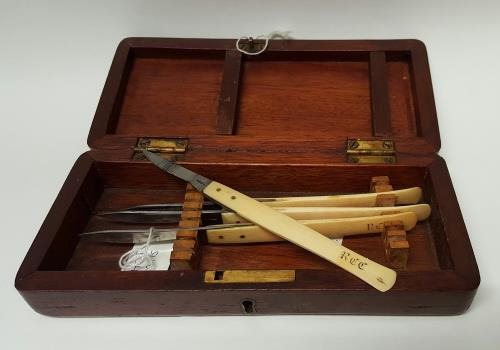
Introduce Burk and Hare in Edinburgh, Scotland during the 1800’s. Hare had several lodgers in his boarding house, and after one of them died, the two decided to sell the body to Knox. Why? Well, the dead man did owe rent, which justified the action in their eyes.
Knox agreed to take the body and paid them, and the two men were so pleased by the sum, they proceeded to kill another lodger who was sick. Again Knox took the body without question and paid them, and suddenly the two men had new ambitions.
Through murder, they began “creating” bodies to sell, and became quite good at it. They were, eventually, caught, and found guilty of murdering 15 people(though it is estimated to be much greater).
Hare somehow managed to be released and Knox escaped punishment (though his career was ruined), but Burk was publicly executed to a cheering crowd, and his body (in a strange twist of justice ) was donated to science.
The story above was the one I had heard before going to Scotland. The part that was left out was what gave a bit of a shock.
So now, back to me, wandering and looking with morbid curiosity at the displays in the Surgeons Hall Museum. You might see a human skull, historical medicine kits, patches of skin with tattoos, and more. If you have ever been curious about the dark side of history, this wonderful museum does not shy away from anything.
It was a surreal experience, but it was made even more so when I found myself looking at a death mask and a book bound with human skin.
Under the hands of anatomy students, his body became a treasure trove of souvenirs. His skin was used for books, his skeleton used for display( currently at the Anatomical Museum of the Edinburgh Medical School), and they made a death mask so you can see just what he looked like.
Those three things I mentioned above? They were from Burke. So, the man who used to sell bodies to science became a body for science himself.
If you are not faint of heart and find yourself in Edinburgh, the Surgeons Hall Museum is for sure worth a visit.
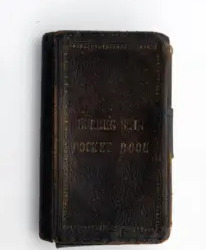
1 note
·
View note
Text
One More Round: The Disturbing Last Drink of John Shaw
When a place has a name like Canyon Diablo you can only assume it earned that moniker for a reason, especially when it looks almost as sinister as it sounds. The Arizona chasm is large and seems to appear out of nowhere, the former site of a railroad town that boasts stories filled to the brim with every character of old west drama. Yes, its origin is unusual, a small community that came about in December 1881 when railroad crews moving west from Albuquerque had to stop laying tracks because they ran into the massive schism in the earth that they could not cross until a bridge was built. But many of the other stories of Canyon Diablo, the whiskey-and-blood-soaked streets, the air thick with violence, the graveyard that simply ran out of room, were all fabrications penned by a novelist long after the inhabitants of the fabled little town moved on.
There is one specific tale from Canyon Diablo though, that is true. And it is just as gruesome as any of the myths and rumors.

Canyon Diablo circa 1890. Image via public domain.
It was after 1am on April 8th 1905 but the Wigwam Saloon in Winslow, Arizona was still hopping and the liquor was flowing. Drinks may have been what was on the minds of John Shaw and William Evans when they first entered the building, but they soon shifted their attention. Their drinks were sitting untouched on the bar when the two walked over to a nearby dice table where the glitter of silver dollars caught their eyes. Their approach may have seemed innocent at first, by all accounts the men were young, in their twenties, and well dressed in suits as they walked up to the table. But, their intent became clear once they pulled their guns on the players and gave them a dire warning to cooperate. After robbing the players of over $200 they ran off into the night.
When Navajo County Sheriff Chet Houck and Deputy Pete Pemberton went looking for the thieves they might have expected an easy job. After all, the two men left a trail of coins behind them leading the sheriff and deputy straight to the railroad tracks. They followed the tracks twenty-five miles until they found themselves in Canyon Diablo. Once in the old town they found trading post operator Fred Volz and asked if he had seen the men, but they did not have to press him for any information. As they were talking to Volz the robbers began walking right up to them.
The men exchanged a few words but soon guns were drawn and bullet-laced smoke took over the scene. The combat was close, Shaw and Houck were only feet from each other, and it proved to be Shaw’s undoing. Twenty-one total shots were fired but at one point Shaw turned away from his opponent and that is when Sheriff Houck put the fatal bullet in his head. When the fight was over there were injuries and close calls all around, but Shaw was the only one killed in the shootout. Volz, still inside the trading post, provided a simple pine box for the body and the outlaw was quickly buried near where he fell.
Word of the encounter traveled fast and by the next night it was circulating around the Wigwam Saloon where the story was heard by members of an Arizona cattle outfit stopping along their route. Going head-to-head with law enforcement was nothing new to the men, but what was truly shocking to them was that Shaw died without ever getting to enjoy the drink he ordered at the bar.
This was unacceptable. Fifteen of the cowboys stood up, grabbed whiskey bottles, and got on the next train to Canyon Diablo.
Volz may have still been shaken from the gunfight the night before when he was suddenly woken up to the sound of banging on his door. What he found outside was a mob of cowboys armed with liquor bottles and demanding information about Shaw’s grave. Then they told Volz the purpose of their visit. Shaw never got to have his drink. They had the liquor…now they needed Shaw.
As disturbed as Volz may have been at what the mob was telling him he eventually gave in and handed over the shovels they demanded. He also handed them a camera stating that pictures would help make sure the dead man was identified correctly.
The plan was simple, dig up Shaw and share his final drink with him. As reported later on by cowboy Lucien Creswell. “We stopped at the depot and had a few more drinks and then we went and dug the grave open with the shovels…” Amazingly, despite his violent end Shaw was in remarkably good shape, “looking very natural, his head not busted open.” Once they laid eyes on Shaw laying peacefully in his makeshift grave the scene became much more serious. Wagon boss J.D. Rogers instructed his men to take him out of the ground, ordering “Let’s get him out. Let’s give him a drink and put him away proper. Somebody can say a prayer, which wasn’t done when they shoved him into that hole.”
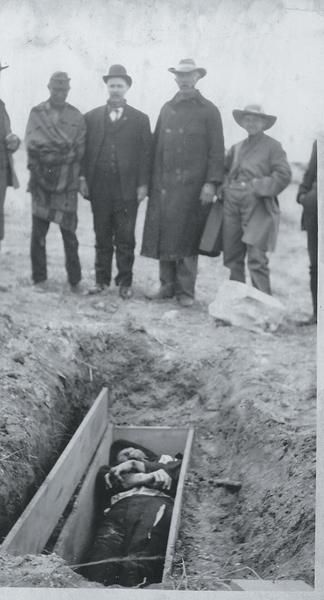
Shaw in his casket. Image via truewestmagazine.com. Courtesy Arizona Historical Society; John Shaw Collection.
Two men jumped into the grave, lifted his body to the waiting hands, and propped him up against a fence that was situated next to another grave. His eyes were open, his lifeless face was frozen in a smile, and the men put the bottles up to his teeth pouring the whiskey down the dead man’s throat. Shaw finally got to have his last drink.
After the liquor was gone the men solemnly placed Shaw back into his coffin, rested a bottle on his chest, and removed their hats for some hasty prayers before covering his body for the final time.
Throughout the entire ceremony six photographs were taken by an unknown cowboy in attendance. When the camera was returned to Volz he unloaded the film and handed it to Creswell, instructing him to give it to Sheriff Houck upon his return to Winslow. However, cowboy Sam Case had other ideas. Case had a grudge against Sheriff Houck’s brother and along the way back to Winslow Case confronted Creswell and took the film from him stating “Houck ain’t gonna get no pictures.” From here the roll of film passed from hand to hand, carrying the story of John Shaw along with it. Finally, a month after the impromptu funeral at Canyon Diablo Case handed the roll of film to Winslow attorney “Judge” Burbidge, who then passed it along to his son Ted. The photographs would not see the light of day until years later when the film came into the possession of a man named Gladwell Richardson who wrote an article about them in a 1965 issue of Arizona Highways magazine.

Trio of photographs taken of the last drink of John Shaw. Image via truewestmagazine.com. Courtesy Arizona Historical Society; John Shaw Collection.
Today four of the photographs taken at the last drink of John Shaw belong to the Arizona Historical Society as part of their John Shaw collection. One photograph was allegedly kept by Ted Burbidge but several years after his death in 1955 the photograph went missing. Along with the Burbidge photograph, the location of the sixth image taken that bizarre morning is also unknown.
Canyon Diablo is a place filled with myths and legends of the Wild West, many of which are horrific. Although mostly debunked we have photographic proof that one of the gory stories did happen, the tale of the corpse that was dug up to have one last drink.
************************************************************************
Sources:
Canyon Diablo, Arizona: Why nearly all the stories about it are lies by Scott Craven for azcentral.com
https://www.azcentral.com/story/travel/arizona/road-trips/2018/10/17/canyon-diablo-arizona-shootouts-myths-legends/1533865002/
One for the grave by Leo W. Banks for TrueWestMagazine.com
https://truewestmagazine.com/one-for-the-grave/
Last Drink: The Almost Unbelievable Story of John Shaw by Julie McDonald as part of the Arizona History series. Published July 23, 2020.
#husheduphistory#featuredarticles#history#ArizonaHistory#Arizona#weirdhistory#forgottenhistory#horrorhistory#creepyhistory#strangehistory#widwest#oldwest#cowboys#gunslinger#CanyonDiablo#truth is stranger than fiction#wildwestshootout#truestory#strange stories#strangestory#weirdstory#nightmarefuel#creepystory#whiskeyhistory#tragictale#tragicstory#railroadhistory
3 notes
·
View notes